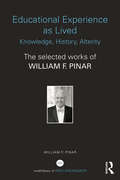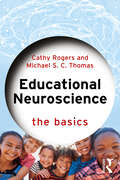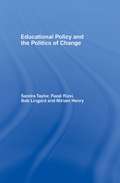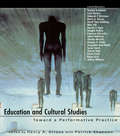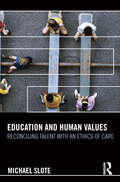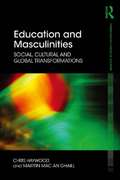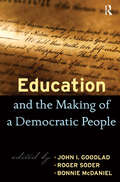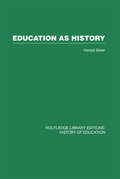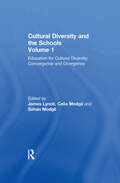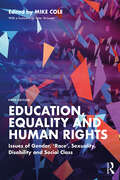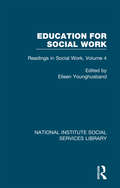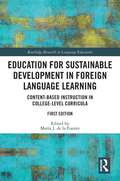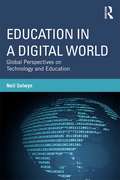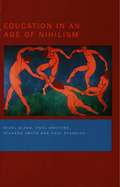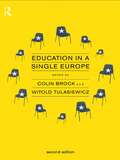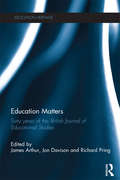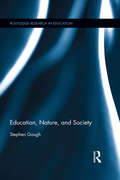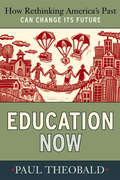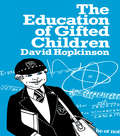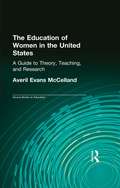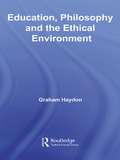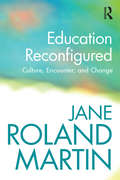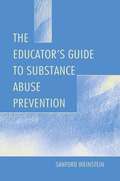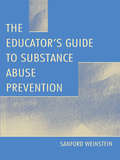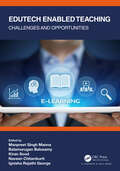Special Collections
Benetech’s Global Certified Accessible Titles
Description: Benetech’s GCA program is the first independent third-party EPUB certification to verify ebook accessibility. By creating content that is born accessible, publishers can meet the needs of all readers. Learn more: https://bornaccessible.benetech.org/
- Table View
- List View
Educational Experience as Lived
by William F. PinarIn this volume, Pinar enacts his theory of curriculum, detailing the relations among knowledge, history, and alterity. The introduction is Pinar’s intellectual life history, naming the contributions he has made to understanding educational experience. Study is the center of educational experience, as he demonstrates in the opening chapter. The alterity of educational experience is evident in his conceptions of disciplinarity and internationalization, interrelated projects of historicization, dialogical encounter, and recontextualization. By reactivating the past, not by instrumentalizing the present, we can find the future, explicated in his studies of the Eight-Year Study, the Tyler Rationale, and the gendering and racialization of U.S. school reform. The interrelation of race and gender is emphasized in the chapters on Ida B. Wells and Jane Addams. The technologization of education is critiqued through analysis of the achievements of George Grant and Pier Paolo Pasolini. The educational project of subjective and social reconstruction is explored through study of Musil’s essayism, a genre that corrects the problems accompanying ethnography and created by identity politics.
Educational Neuroscience
by Michael S. Thomas and Cathy RogersEducational Neuroscience: The Basics is an engaging introduction to this emerging, interdisciplinary field. It explains how the brain works and its priorities for learning, and shows how educational neuroscience, when combined with existing knowledge of human and social psychology, and with teacher expertise, can improve outcomes for students. Cathy Rogers and Michael S. C. Thomas reveal how neuroscientific evidence is forcing us to question our assumptions about how our brains learn and what this means for education. The chapters in this vital volume step through the brain’s priorities: processing senses and moving our bodies, emotional processing, and the difficult job of dealing with other people. It unpacks the tricky tasks of thinking and learning, considering how memory works and the many systems involved in learning. It draws this all together to offer guidance for effective classroom practice, current and future. Chapter features include key issues for special educational needs and neurodiversity, case studies of novel interventions, debunking of common neuromyths, and guidance for teachers on how to evaluate their own practice. This book is a compact, lively introductory text for students of psychology, neuroscience and education and courses where these disciplines interconnect. It will also be essential reading for educational professionals, including teachers, heads, educational advisors and the many industry bodies who govern and train them, as well as anyone interested in the fascinating story of how we learn.
Educational Policy and the Politics of Change
by Sandra Taylor and Fazal Rizvi and Bob Lingard and Miriam HenryGovernments around the world are trying to come to terms with new technologies, new social movements and a changing global economy. As a result, educational policy finds itself at the centre of a major political struggle between those who see it only for its instrumental outcomes and those who see its potential for human emancipation. This book is a successor to the best-selling Understanding Schooling (1988). It provides a readable account of how educational policies are developed by the state in response to broader social, cultural, economic and political changes which are taking place. It examines the way in which schools live and work with these changes, and the policies which result from them. The book examines policy making at each level, from perspectives both inside and outside the state bureaucracy. It has a particular focus on social justice. Both undergraduate and postgraduate students will find that this book enables them to understand the reasoning behind the changes they are expected to implement. It will help to prepare them to confront an uncertain educational world, whilst still retaining their enthusiasm for education.
Education and Cultural Studies
by Henry A. Giroux and Patrick ShannonFirst Published in 1998. Routledge is an imprint of Taylor & Francis, an informa company.
Education and Human Values
by Michael SloteTwo of our greatest educational theorists, John Dewey and Nel Noddings, have been reluctant to admit that some students are simply more talented than others. This was no doubt due to their feeling that such an admission was inconsistent with democratic concern for everyone. But there really is such a thing as superior talent; and the present book explains how that admission is compatible with our ideals of caring (and democracy). Traditionalists confident that some disciplines are more important than others haven’t worried that that way of putting things threatens to make those who are excluded feel quite bad about themselves. But an ethics of care can show us how to make these differences much less hurtful and more morally acceptable than anything that has been proposed by traditionalists. So the present book offers a middle way between the denial of the reality of superior talents and an insensitive insistence on that reality. It argues that care ethics gives us a way to do this, and it bases that claim largely on the promise of such an ethics for moral education in schools and in homes. It is argued on psychological grounds that caring can only take place on the basis of empathy for others, and the book shows in great detail how empathy can be encouraged or develop in school and home contexts. Other approaches to moral education—like Kantian cognitive-developmentalism and Aristotelian character education—can’t account for (increasing) moral motivation in the way that an emphasis on the development of empathy allows. And in the end, it is only students educated via care ethics who will be sensitive to one another in a way that largely undercuts the negative psychological impact of educational institutions and practices that acknowledge the greater talents or creativity that some students have.
Education and Masculinities
by Chris Haywood and Mairtin Mac an GhaillAcross media, academy and popular culture in western societies there is much talk of an implosion of the modern gender order. Education is often presented as a key site in which a crisis of masculinity is played out, and schools have become a focus for practical attempts to reconcile social and cultural transformations through the recalibration of teaching and learning, increasing male teachers and masculinising the content of subjects. Education and Masculinities argues that we are experiencing a shift from the establishment of the social constitution of gender associated with modernity politics, to the gendering of society that has an intensified resonance among men and women in a global-based late modernity. The book explores the main social and cultural approaches to education and masculinities within the broader context of sex and gender relations, considering the masculinity question alongside local and global changes in society, and bringing a fresh evaluation of key issues. Included in the book: -how the suggestion of ‘academically successful girls’ and ‘failing boys’ plays out in relation to issues of inequality across class and ethnicity -a current empirical analyses of gender inequality across schools, higher education and the labour market -representation, identity and cultural difference with reference to male and female social experiences and cultural meanings -forms of power connected to social divisions and cultural differences. Education and Masculinities provides a critical yet constructive diagnosis of gender relations across educational sites, exploring both academic accounts and alternative global responses that illustrate the limits of Western models and sensibilities.This accessible book will be valuable reading for students following courses in education, sociology, gender studies, and other social sciences and humanities courses.
Education and the Making of a Democratic People
by Bonnie Mcdaniel and John I. Goodlad and Roger SoderUnfortunately, civic values such as equity and justice that constitute the moral grounding of American democracy are losing their place in public affairs. The promise of this democracy is inclusive: no one is to be left out. Yet many people are. Education and the Making of a Democratic People regards the challenge of inclusiveness as a fundamental and non-negotiable educational agenda. America's public schools are a main public forum in which people can learn to preserve and actively protect our democratic process. The value of our schools as a democratic forum extends beyond the classroom to parents and other members of local communities. By engaging in conversations and actions that support the democratic purpose of schools, local communities can ensure that the United States will become a healthy, robust democracy that represents all of its citizens.
Education as History
by Harold SilverOriginally published 1983.This book explores the nature of the social history of education. It examines what aspects of the history of education have been neglected and why. The themes explored include the relationship between education and the emergence of social science, the reputations of educationists, expectations of higher education in the twentieth century, the use of education against poverty and education as policy and case study.
Education Cultural Diversity
by James Lynch and Sohan Modgil and Celia ModgilFirst published in 1992. Routledge is an imprint of Taylor & Francis, an informa company.
Education, Equality and Human Rights
by Mike ColeThe fifth edition of the market-leading Education, Equality and Human Rights has been fully updated to reflect economic, political and cultural changes in the UK, including the impacts of Brexit and Covid-19. It considers the great changes we are witnessing in recent years, such as climate change emergency, pandemics, the Fourth Industrial Revolution and their interrelationships. Written by world experts in their respective fields, each of the five equality issues of gender, race, sexuality, disability and social class is covered in their own right as well as in relation to education. Key issues explored include: • human rights, equality and education • women and equality—historically and now • gender, education and social change • race and racism through history and today • racism and education from Empire to Johnson • sexualities, identities and equality • challenges in teaching and learning about sexuality and homo- and trans-phobia in schools • disability equality as the last Civil Right? • developing inclusive education and governments’ resistance • social class, neoliberal capitalism and the Marxist alternative • selective schooling, mystifying social class, neoliberalism and alternatives With an uncompromising and rigorous analysis of equality issues and a foreword from Peter McLaren addressing challenges to democracy in the US, this new edition of Education, Equality and Human Rights is an essential and contemporary resource across a wide range of disciplines and for all those interested in education, social policy and human rights.
Education for Social Work
by Eileen YounghusbandSome outstanding contributions to a better understanding of the issues of education for social work have been brought together in this volume, originally published in 1968. Because of the wide relevance of the subject these articles should be valuable not only to social work educators and field supervisors in many different parts of the world, but to others concerned with professional education. Today it can be enjoyed in its historical context.
Education for Sustainable Development in Foreign Language Learning
by María J. de la FuenteThis unique volume utilizes the UNESCO Education for Sustainable Development (ESD) framework to illustrate successful integration of sustainability education in post-secondary foreign language (FL) learning. Showcasing a variety of approaches to using content-based instruction (CBI) in college-level courses, this text valuably demonstrates how topics relating to environmental, social, and cultural dimensions of sustainability can be integrated in FL curricula. Chapters draw on case studies from colleges throughout the US and consider theoretical and practical concerns relating to models of sustainability-based teaching and learning. Chapters present examples of project-, problem-, and task-based approaches, as well as field work, debate, and reflective pedagogies to enhance students’ awareness and engagement with sustainable development issues as they acquire a foreign language. Insights and recommendations apply across languages and highlight the potential contribution of FL learning to promote sustainability literacy amongst learners. This text will benefit researchers, academics, and educators in higher education with an interest in Modern Foreign Languages, sustainability education, training, and leadership more broadly.
Education in a Digital World
by Neil SelwynDrawing on a wealth of theoretical and empirical work, Education in a Digital World tackles a number of pressing questions, such as, how are ‘global’ trends in educational technology refracted through national policies and processes? How exactly are educational technologies linked to issues of global economics and the fortunes of national and international economies? To what extent are digital technologies implicated in the commercialisation, marketization and commodification of education? These questions, and others, are addressed throughout eight wide-ranging chapters, which consider topics such as the national policy strategies of countries across North and South America, Europe and East Asia, the educational technology portfolios of international organizations such as the United Nations and Microsoft, as well as the role of education and technology in international development and the on-going efforts to provide ‘one laptop per child’ across low-income regions and countries. Through these examples Selwyn develops a detailed analysis of education, technology and globalisation, drawing together arguments and debates from various academic perspectives. Written in a detailed but accessible manner, this is an essential book for anyone wishing to gain a better understanding of the role of education and technology in contemporary globalised society.
Education in an Age of Nihilism
by Richard Smith and Paul Smeyers and Paul Standish and Nigel BlakeThis book addresses concerns about educational and moral standards in a world increasingly characterised by nihilism. On the one hand there is widespread anxiety that standards are falling; on the other, new machinery of accountability and inspection to show that they are not. The authors in this book state that we cannot avoid nihilism if we are simply laissez-faire about values, neither can we reduce them to standards of performance, nor must we return to traditional values. They state that we need to create a new set of values based on a critical assessment of contemporary practice in the light of a number of philosophical texts that address the question of nihilism, including the work of Nietzsche.
Education in a Single Europe
by Colin Brock and Witold TulasiewiczThis book brings together contributors from the different member states of the European Union in order to understand the different degrees of subscription to the concept of Europe and the role education plays in such a process. This second edition includes the new countries which have become part of the union and also considers recent developments in policy and practice. Countries covered are: Austria; Belgium; Denmark; Finland; France; Germany; Greece; Ireland; Italy; Luxembourg; Netherlands; Portugal; Spain; Sweden and the UK. All sectors of education are dealt with in each case and the central theme of the European dimension is examined throughout.
Education Matters
by J. Arthur and J. Davison and R. PringEducation Matters draws together a selection of the most influential papers published in the British Journal of Educational Studies by many of the leading scholars in the field over the past sixty years. This unique collection of seminal articles published since the first issue of the Journal provides students and researchers in education with an informed insight and understanding of the nature the development of the field of Educational Studies in the United Kingdom since the Second World War. It also assesses the current position of Educational Studies and explores the possibilities for the development of the field in coming years. Compiled by the journal's editors, past and present, James Arthur, Jon Davison and Richard Pring, the book illustrates the development of the field of educational studies, and the specially written Introduction contextualises the selection, whilst introducing students to the main issues and current thinking in the field. Each of the twenty articles includes a preface which highlights the changing conceptions and development of, or consistency in, educational thought over time, as well as debates and conflicts in the seminal articles by key educational thinkers that have been published in the Journal.
Education, Nature, and Society
by Stephen GoughEnvironmental issues continue to divide opinion, sometimes in extreme ways. Almost everyone agrees that education has a role to play in ensuring the future of humanity on Earth. Some think we should all learn to leave a minimal environmental footprint; others argue that education should promote economic growth, because only growth can generate the capital needed to develop solutions to environmental problems. Advocates on each side often find the views of their opponents simply incredible, giving rise to accusations of bad faith or poor science. This book explores the foundations of the debate by examining human interrelations with Nature. It takes an educational perspective, but also draws on evidence from anthropology, economics, ecology, policy sciences and natural history. The case presented is that any coherent view of the purposes and potential of education requires a theory of human society in the natural world. For such a theory, education (and, more broadly, learning) must be more than an instrument for the achievement of personal or policy goals. Rather, it is an integral, continuing and necessary component of personal and policy development. On this basis, a novel approach to curriculum design and implementation is outlined.
Education Now
by Paul TheobaldEducation Now is a clear and persuasive account of the way in which popular seventeenth- and eighteenth-century theories about the human condition formed the basis for America's choices in the realms of politics, economics, and education. Theobald chronicles the fate of alternative, less popular ideas about the human condition-ideas that would have led to vastly different political, economic, and educational landscapes than those we experience today. This book exposes the flaws among prevalent theories and the strength of those alternatives that were dismissed or ignored. In so doing, Theobald points the way toward substantive changes across three dimensions ubiquitous to human life: politics, economics, and education.
The Education of Gifted Children
by David HopkinsonFirst Published in 1978. Routledge is an imprint of Taylor & Francis, an informa company.
The Education of Women in the United States
by Averil Evans McClellandFirst Published in 1992. Routledge is an imprint of Taylor & Francis, an informa company.
Education, Philosophy and the Ethical Environment
by Graham HaydonHow much can we reasonably expect from education? This book, written by a philosopher of education, casts new light on this question by seeing values education, not as a separate activity within schools, but as an aspect of education that both reflects the surrounding climate of values and can help to change it. Graham Haydon argues that all of us – whether as teachers, parents, students or citizens – share in a responsibility for the quality of that ethical environment. He argues that we must ensure that what happens in schools will: enable young people to appreciate the diversity of our ethical environment help them find their way through its complexities contribute to developing a climate of values that is desirable for all. This book shows that values education is too demanding to be left to parents and too important to be entrusted to government initiatives. For teachers engaged in values education, this book brings a fresh perspective to what they are doing, within a realistic view of their responsibilities. For students of education, it shows that practical issues can be illuminated by insights from philosophy.
Education Reconfigured
by Jane Roland MartinAs philosophers throughout the ages have asked: What is justice? What is truth? What is art? What is law? In Education Reconfigured, the internationally acclaimed philosopher of education, Jane Roland Martin, now asks: What is education? In answer, she puts forward a unified theory that casts education in a brand new light. Martin’s "theory of education as encounter" places culture alongside the individual at the heart of the educational process, thus responding to the call John Dewey made over a century ago for an enlarged outlook on education. Look through her theory’s lens and you can see that education takes place not only in school but at home, on the street, in the mall—everywhere and all the time. Look through that lens and you can see that education does not always spell improvement; rather, it can be for the better or the worse. Indeed, you can see that education is inevitably a maker and shaper of both individuals and cultures. Above all, Martin’s new educational paradigm reveals that education is too important to be left solely to the professionals; that it is one of the great forces in human society and, as such, deserves the attention and demands the vigilance of every thoughtful person.
The Educator's Guide To Substance Abuse Prevention
by Sanford WeinsteinThe Educator's Guide to Substance Abuse Prevention is for educators and other school personnel who are concerned about student drug use and school violence. It will help them to appreciate and use their humanity, professional skills, educational ideals, and the school curriculum as tools for substance abuse prevention. Teachers' concerns are addressed in several ways. First, the text provides a guide through which they may resolve personal and professional concerns about the commitments, limits, and boundaries of their working relationships with students. Second, it describes tasks that teachers can perform and mental health issues they can address in creating classroom policies, procedures, and rules to promote healthful learning activity in the classroom. Third, the author summarizes and interprets research and theory about substance abuse as they apply specifically to educational prevention and to professional teaching practice--arguing that classroom management strategies, learning activities, and social interaction are a teacher's primary tools of prevention, and showing how teachers may use these tools in any curricular area and without direct reference to drugs. A highlight of this text is its emphasis on helping teachers to explore drug-related issues from within the context of their own curricular specialties and to integrate substance abuse prevention with the curriculum in many school subjects--including the arts, literature, social studies, history, government, science, and culture. Action-oriented prevention strategies based on these content areas are suggested. The Educator's Guide to Substance Abuse Prevention: *focuses primarily on teaching, learning, and prevention rather than on information about drugs; *helps teachers to better use what they already do, know, and are in order to respond competently, responsibly, and with sensitivity to the needs of their students; *attends to the needs of teachers who do prevention work and the needs of children who are the target of prevention efforts; *describes student disappointment and disillusionment with family, school, and community as sources of risk and the legitimate domain in which teachers may serve a curative role; *provides extensive coverage of historical, social, and cultural issues related to substance abuse and school violence; and *alerts teachers to the risk to children posed by extremist adult groups, prominent negative role models, popular culture, and peer pressure.
The Educator's Guide To Substance Abuse Prevention
by Sanford WeinsteinThe Educator's Guide to Substance Abuse Prevention is for educators and other school personnel who are concerned about student drug use and school violence. It will help them to appreciate and use their humanity, professional skills, educational ideals, and the school curriculum as tools for substance abuse prevention. Teachers' concerns are addressed in several ways. First, the text provides a guide through which they may resolve personal and professional concerns about the commitments, limits, and boundaries of their working relationships with students. Second, it describes tasks that teachers can perform and mental health issues they can address in creating classroom policies, procedures, and rules to promote healthful learning activity in the classroom. Third, the author summarizes and interprets research and theory about substance abuse as they apply specifically to educational prevention and to professional teaching practice--arguing that classroom management strategies, learning activities, and social interaction are a teacher's primary tools of prevention, and showing how teachers may use these tools in any curricular area and without direct reference to drugs. A highlight of this text is its emphasis on helping teachers to explore drug-related issues from within the context of their own curricular specialties and to integrate substance abuse prevention with the curriculum in many school subjects--including the arts, literature, social studies, history, government, science, and culture. Action-oriented prevention strategies based on these content areas are suggested. The Educator's Guide to Substance Abuse Prevention: *focuses primarily on teaching, learning, and prevention rather than on information about drugs; *helps teachers to better use what they already do, know, and are in order to respond competently, responsibly, and with sensitivity to the needs of their students; *attends to the needs of teachers who do prevention work and the needs of children who are the target of prevention efforts; *describes student disappointment and disillusionment with family, school, and community as sources of risk and the legitimate domain in which teachers may serve a curative role; *provides extensive coverage of historical, social, and cultural issues related to substance abuse and school violence; and *alerts teachers to the risk to children posed by extremist adult groups, prominent negative role models, popular culture, and peer pressure.
Edutech Enabled Teaching
by Manpreet Singh Manna Balamurugan Balusamy Kiran Sood Naveen Chilamkurti Ignisha Rajathi GeorgeThe primary goal of this book is to address the issues faced by teachers in the adoption of digital tools into their teaching and their students learning. This book also addresses the issues confronting educators in the integration of digital technologies into their teaching and their students’ learning. Such issues include a skepticism of the added value of technology to educational learning outcomes, the perception of the requirement to keep up with the fast pace of technological innovation, a lack of knowledge of affordable educational digital tools and a lack of understanding of pedagogical strategies to embrace digital technologies in their teaching. This book presents theoretical perspectives of learning and teaching today’s digital students with technology and proposes a pragmatic and sustainable framework for teachers’ professional learning to embed digital technologies into their repertoire of teaching strategies in a systematic, coherent and comfortable manner so that technology integration becomes an almost effortless pedagogy in their day-to-day teaching. Some of the objectives are given below: Shares valuable insights into the influence of technology on teaching and learning in higher education Provide deeper insights on higher education and sustainability interact Studies innovations from various perspectives Investigate how the educators and students apply the unique innovative and emotional dimensions in modern age of learning Provides a timely overview of changes in education reforms and policy research globally Evaluates the problematic relationship between globalization, the state, and education reforms.
